Leadership and Organization: An Analysis of Apple Company's Practices
VerifiedAdded on 2021/06/17
|17
|4341
|32
Report
AI Summary
This report delves into the core principles of managing people and organizations, focusing on planning, organizing, leadership, and control. It provides a personal reflection on these principles, drawing upon the student's experiences in high school and their application to achieving academic goals. The report then transitions to an analysis of management theories, specifically Frederick Taylor's Scientific Management Theory and Max Weber's Bureaucracy Theory, using Apple as a practical case study. The report examines how Apple's organizational leadership aligns with, or diverges from, these theoretical frameworks. It evaluates the relevance of both theories by observing Apple's work culture and offering an unbiased assessment. The individual reflection section covers the importance of planning, organizing, leadership, and control, and the importance of these elements in achieving organizational goals. The report also provides a detailed analysis of the leadership styles exhibited by leaders, and how they can be used to inspire and motivate employees. The report also discusses the importance of controlling in an organization and how it helps in ensuring that the performance of the employees is not deviating from the estimated standards. The report concludes with a summary of the key findings and recommendations.
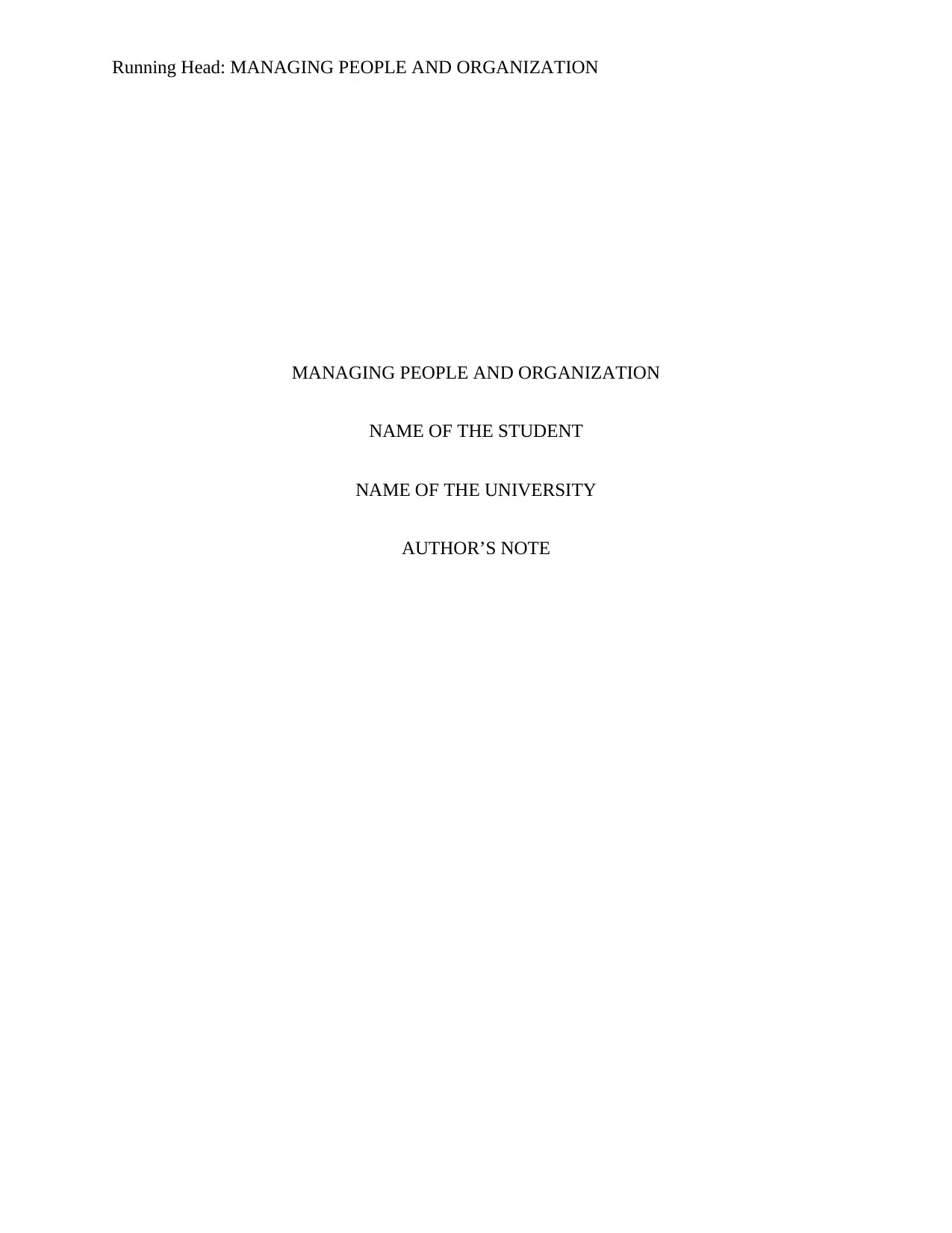
Running Head: MANAGING PEOPLE AND ORGANIZATION
MANAGING PEOPLE AND ORGANIZATION
NAME OF THE STUDENT
NAME OF THE UNIVERSITY
AUTHOR’S NOTE
MANAGING PEOPLE AND ORGANIZATION
NAME OF THE STUDENT
NAME OF THE UNIVERSITY
AUTHOR’S NOTE
Paraphrase This Document
Need a fresh take? Get an instant paraphrase of this document with our AI Paraphraser
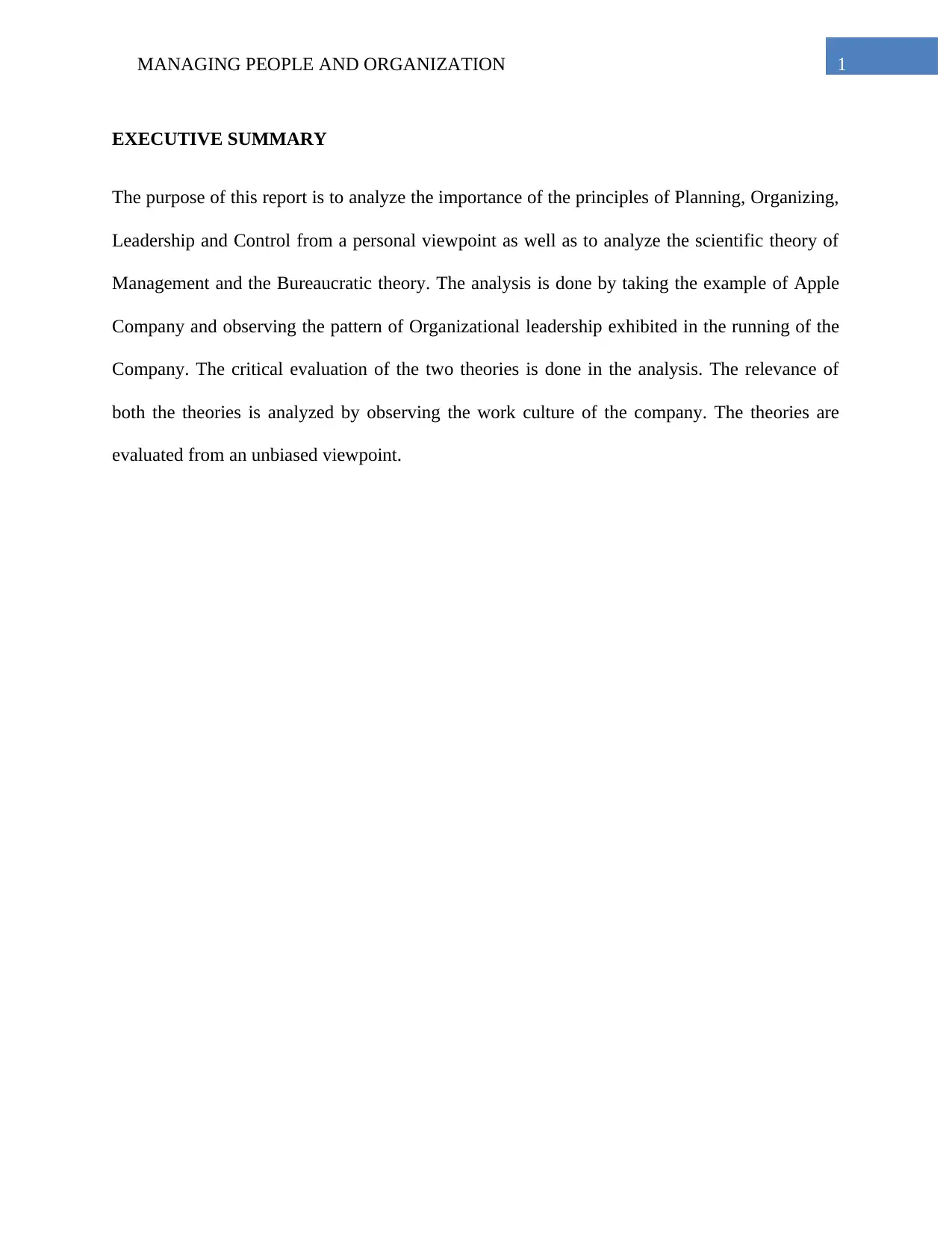
1MANAGING PEOPLE AND ORGANIZATION
EXECUTIVE SUMMARY
The purpose of this report is to analyze the importance of the principles of Planning, Organizing,
Leadership and Control from a personal viewpoint as well as to analyze the scientific theory of
Management and the Bureaucratic theory. The analysis is done by taking the example of Apple
Company and observing the pattern of Organizational leadership exhibited in the running of the
Company. The critical evaluation of the two theories is done in the analysis. The relevance of
both the theories is analyzed by observing the work culture of the company. The theories are
evaluated from an unbiased viewpoint.
EXECUTIVE SUMMARY
The purpose of this report is to analyze the importance of the principles of Planning, Organizing,
Leadership and Control from a personal viewpoint as well as to analyze the scientific theory of
Management and the Bureaucratic theory. The analysis is done by taking the example of Apple
Company and observing the pattern of Organizational leadership exhibited in the running of the
Company. The critical evaluation of the two theories is done in the analysis. The relevance of
both the theories is analyzed by observing the work culture of the company. The theories are
evaluated from an unbiased viewpoint.
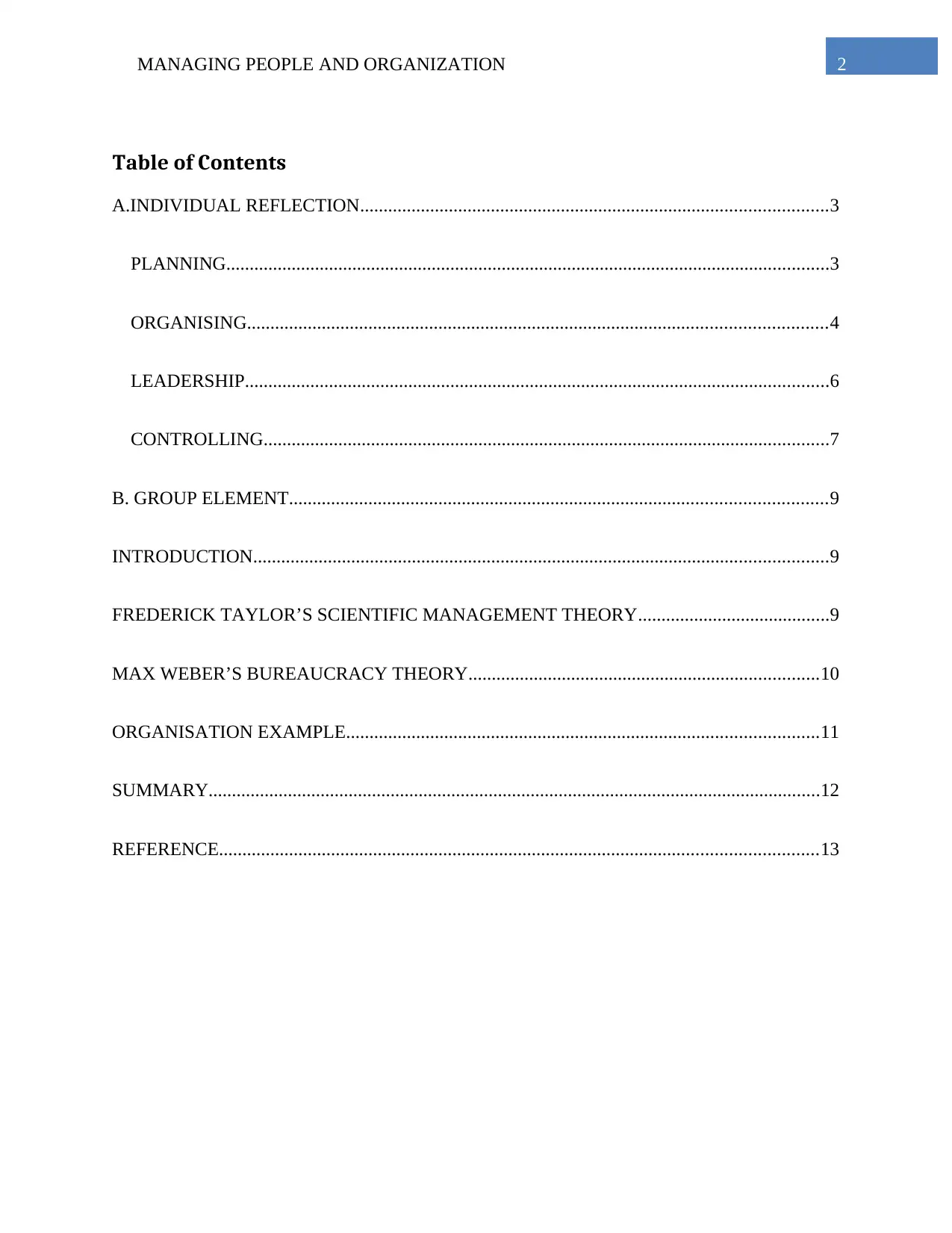
2MANAGING PEOPLE AND ORGANIZATION
Table of Contents
A.INDIVIDUAL REFLECTION....................................................................................................3
PLANNING.................................................................................................................................3
ORGANISING............................................................................................................................4
LEADERSHIP.............................................................................................................................6
CONTROLLING.........................................................................................................................7
B. GROUP ELEMENT...................................................................................................................9
INTRODUCTION...........................................................................................................................9
FREDERICK TAYLOR’S SCIENTIFIC MANAGEMENT THEORY.........................................9
MAX WEBER’S BUREAUCRACY THEORY...........................................................................10
ORGANISATION EXAMPLE.....................................................................................................11
SUMMARY...................................................................................................................................12
REFERENCE................................................................................................................................13
Table of Contents
A.INDIVIDUAL REFLECTION....................................................................................................3
PLANNING.................................................................................................................................3
ORGANISING............................................................................................................................4
LEADERSHIP.............................................................................................................................6
CONTROLLING.........................................................................................................................7
B. GROUP ELEMENT...................................................................................................................9
INTRODUCTION...........................................................................................................................9
FREDERICK TAYLOR’S SCIENTIFIC MANAGEMENT THEORY.........................................9
MAX WEBER’S BUREAUCRACY THEORY...........................................................................10
ORGANISATION EXAMPLE.....................................................................................................11
SUMMARY...................................................................................................................................12
REFERENCE................................................................................................................................13
⊘ This is a preview!⊘
Do you want full access?
Subscribe today to unlock all pages.

Trusted by 1+ million students worldwide
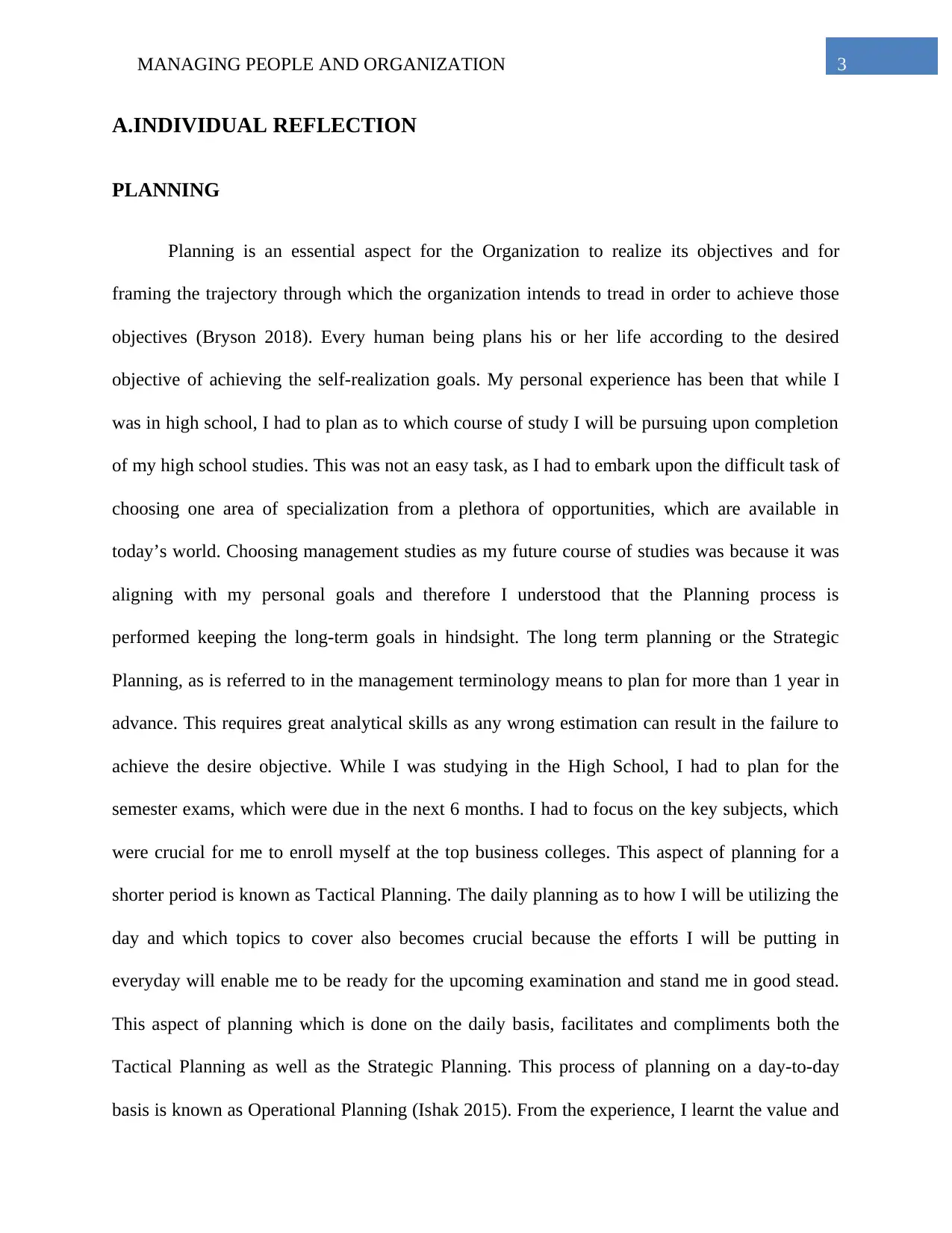
3MANAGING PEOPLE AND ORGANIZATION
A.INDIVIDUAL REFLECTION
PLANNING
Planning is an essential aspect for the Organization to realize its objectives and for
framing the trajectory through which the organization intends to tread in order to achieve those
objectives (Bryson 2018). Every human being plans his or her life according to the desired
objective of achieving the self-realization goals. My personal experience has been that while I
was in high school, I had to plan as to which course of study I will be pursuing upon completion
of my high school studies. This was not an easy task, as I had to embark upon the difficult task of
choosing one area of specialization from a plethora of opportunities, which are available in
today’s world. Choosing management studies as my future course of studies was because it was
aligning with my personal goals and therefore I understood that the Planning process is
performed keeping the long-term goals in hindsight. The long term planning or the Strategic
Planning, as is referred to in the management terminology means to plan for more than 1 year in
advance. This requires great analytical skills as any wrong estimation can result in the failure to
achieve the desire objective. While I was studying in the High School, I had to plan for the
semester exams, which were due in the next 6 months. I had to focus on the key subjects, which
were crucial for me to enroll myself at the top business colleges. This aspect of planning for a
shorter period is known as Tactical Planning. The daily planning as to how I will be utilizing the
day and which topics to cover also becomes crucial because the efforts I will be putting in
everyday will enable me to be ready for the upcoming examination and stand me in good stead.
This aspect of planning which is done on the daily basis, facilitates and compliments both the
Tactical Planning as well as the Strategic Planning. This process of planning on a day-to-day
basis is known as Operational Planning (Ishak 2015). From the experience, I learnt the value and
A.INDIVIDUAL REFLECTION
PLANNING
Planning is an essential aspect for the Organization to realize its objectives and for
framing the trajectory through which the organization intends to tread in order to achieve those
objectives (Bryson 2018). Every human being plans his or her life according to the desired
objective of achieving the self-realization goals. My personal experience has been that while I
was in high school, I had to plan as to which course of study I will be pursuing upon completion
of my high school studies. This was not an easy task, as I had to embark upon the difficult task of
choosing one area of specialization from a plethora of opportunities, which are available in
today’s world. Choosing management studies as my future course of studies was because it was
aligning with my personal goals and therefore I understood that the Planning process is
performed keeping the long-term goals in hindsight. The long term planning or the Strategic
Planning, as is referred to in the management terminology means to plan for more than 1 year in
advance. This requires great analytical skills as any wrong estimation can result in the failure to
achieve the desire objective. While I was studying in the High School, I had to plan for the
semester exams, which were due in the next 6 months. I had to focus on the key subjects, which
were crucial for me to enroll myself at the top business colleges. This aspect of planning for a
shorter period is known as Tactical Planning. The daily planning as to how I will be utilizing the
day and which topics to cover also becomes crucial because the efforts I will be putting in
everyday will enable me to be ready for the upcoming examination and stand me in good stead.
This aspect of planning which is done on the daily basis, facilitates and compliments both the
Tactical Planning as well as the Strategic Planning. This process of planning on a day-to-day
basis is known as Operational Planning (Ishak 2015). From the experience, I learnt the value and
Paraphrase This Document
Need a fresh take? Get an instant paraphrase of this document with our AI Paraphraser
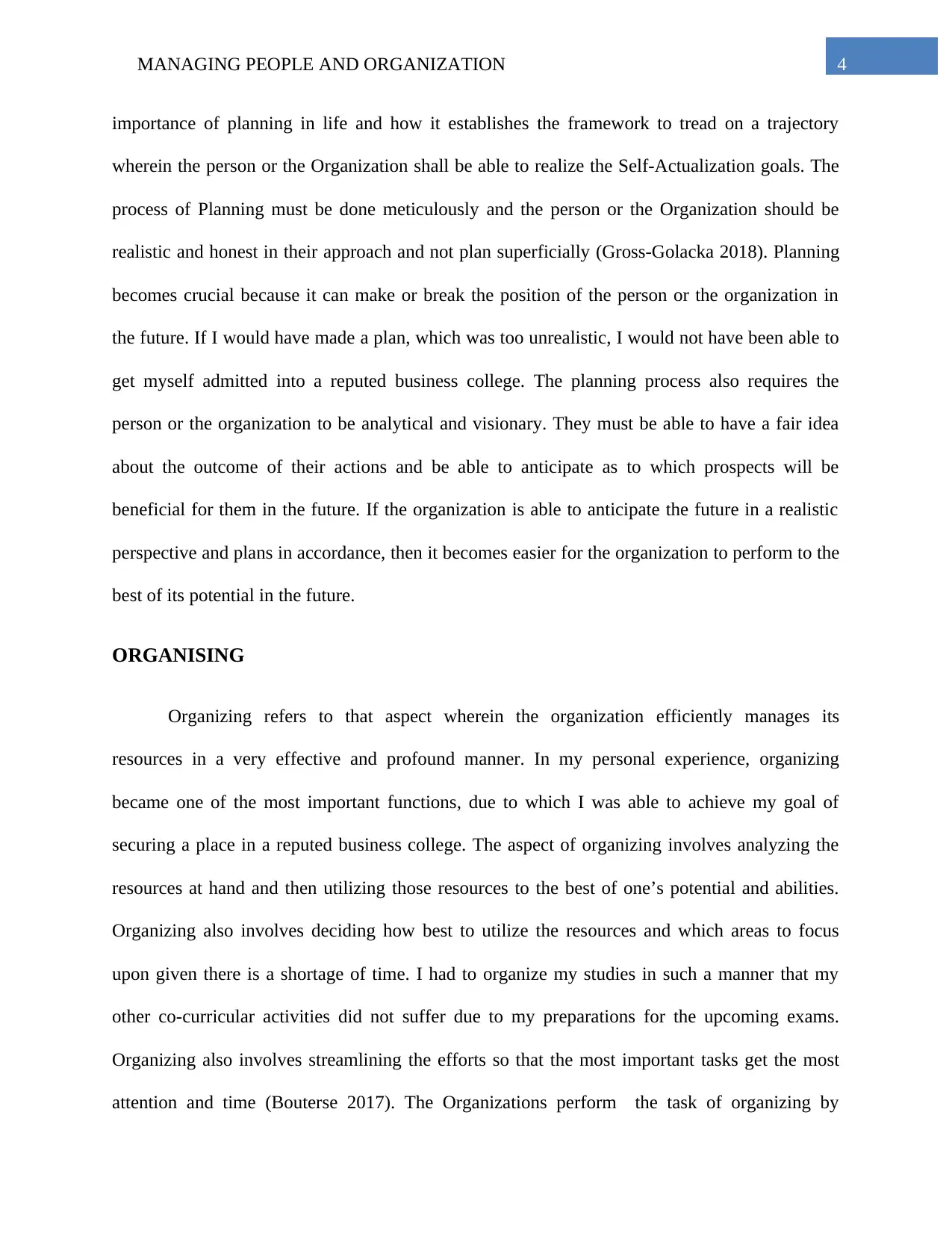
4MANAGING PEOPLE AND ORGANIZATION
importance of planning in life and how it establishes the framework to tread on a trajectory
wherein the person or the Organization shall be able to realize the Self-Actualization goals. The
process of Planning must be done meticulously and the person or the Organization should be
realistic and honest in their approach and not plan superficially (Gross-Golacka 2018). Planning
becomes crucial because it can make or break the position of the person or the organization in
the future. If I would have made a plan, which was too unrealistic, I would not have been able to
get myself admitted into a reputed business college. The planning process also requires the
person or the organization to be analytical and visionary. They must be able to have a fair idea
about the outcome of their actions and be able to anticipate as to which prospects will be
beneficial for them in the future. If the organization is able to anticipate the future in a realistic
perspective and plans in accordance, then it becomes easier for the organization to perform to the
best of its potential in the future.
ORGANISING
Organizing refers to that aspect wherein the organization efficiently manages its
resources in a very effective and profound manner. In my personal experience, organizing
became one of the most important functions, due to which I was able to achieve my goal of
securing a place in a reputed business college. The aspect of organizing involves analyzing the
resources at hand and then utilizing those resources to the best of one’s potential and abilities.
Organizing also involves deciding how best to utilize the resources and which areas to focus
upon given there is a shortage of time. I had to organize my studies in such a manner that my
other co-curricular activities did not suffer due to my preparations for the upcoming exams.
Organizing also involves streamlining the efforts so that the most important tasks get the most
attention and time (Bouterse 2017). The Organizations perform the task of organizing by
importance of planning in life and how it establishes the framework to tread on a trajectory
wherein the person or the Organization shall be able to realize the Self-Actualization goals. The
process of Planning must be done meticulously and the person or the Organization should be
realistic and honest in their approach and not plan superficially (Gross-Golacka 2018). Planning
becomes crucial because it can make or break the position of the person or the organization in
the future. If I would have made a plan, which was too unrealistic, I would not have been able to
get myself admitted into a reputed business college. The planning process also requires the
person or the organization to be analytical and visionary. They must be able to have a fair idea
about the outcome of their actions and be able to anticipate as to which prospects will be
beneficial for them in the future. If the organization is able to anticipate the future in a realistic
perspective and plans in accordance, then it becomes easier for the organization to perform to the
best of its potential in the future.
ORGANISING
Organizing refers to that aspect wherein the organization efficiently manages its
resources in a very effective and profound manner. In my personal experience, organizing
became one of the most important functions, due to which I was able to achieve my goal of
securing a place in a reputed business college. The aspect of organizing involves analyzing the
resources at hand and then utilizing those resources to the best of one’s potential and abilities.
Organizing also involves deciding how best to utilize the resources and which areas to focus
upon given there is a shortage of time. I had to organize my studies in such a manner that my
other co-curricular activities did not suffer due to my preparations for the upcoming exams.
Organizing also involves streamlining the efforts so that the most important tasks get the most
attention and time (Bouterse 2017). The Organizations perform the task of organizing by
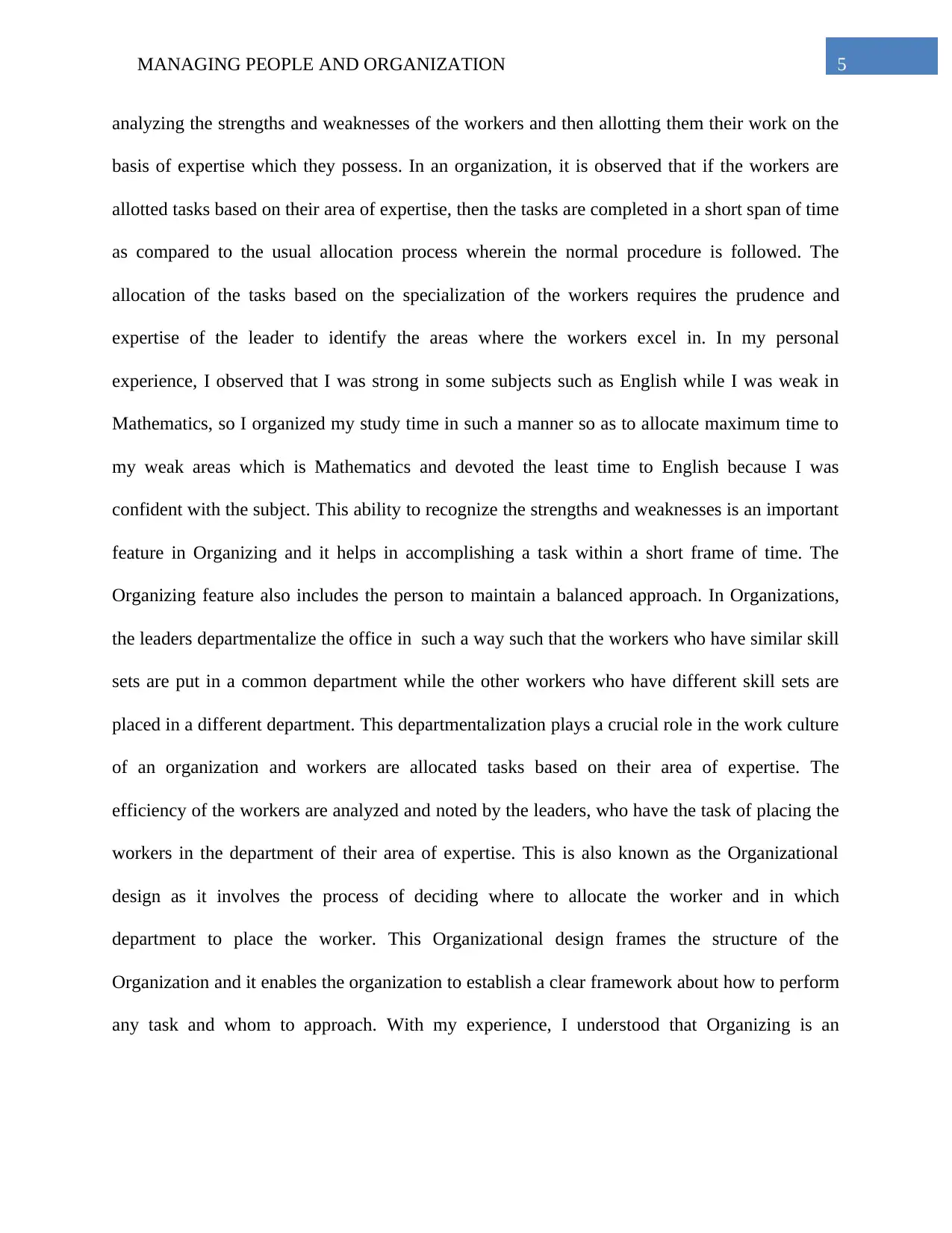
5MANAGING PEOPLE AND ORGANIZATION
analyzing the strengths and weaknesses of the workers and then allotting them their work on the
basis of expertise which they possess. In an organization, it is observed that if the workers are
allotted tasks based on their area of expertise, then the tasks are completed in a short span of time
as compared to the usual allocation process wherein the normal procedure is followed. The
allocation of the tasks based on the specialization of the workers requires the prudence and
expertise of the leader to identify the areas where the workers excel in. In my personal
experience, I observed that I was strong in some subjects such as English while I was weak in
Mathematics, so I organized my study time in such a manner so as to allocate maximum time to
my weak areas which is Mathematics and devoted the least time to English because I was
confident with the subject. This ability to recognize the strengths and weaknesses is an important
feature in Organizing and it helps in accomplishing a task within a short frame of time. The
Organizing feature also includes the person to maintain a balanced approach. In Organizations,
the leaders departmentalize the office in such a way such that the workers who have similar skill
sets are put in a common department while the other workers who have different skill sets are
placed in a different department. This departmentalization plays a crucial role in the work culture
of an organization and workers are allocated tasks based on their area of expertise. The
efficiency of the workers are analyzed and noted by the leaders, who have the task of placing the
workers in the department of their area of expertise. This is also known as the Organizational
design as it involves the process of deciding where to allocate the worker and in which
department to place the worker. This Organizational design frames the structure of the
Organization and it enables the organization to establish a clear framework about how to perform
any task and whom to approach. With my experience, I understood that Organizing is an
analyzing the strengths and weaknesses of the workers and then allotting them their work on the
basis of expertise which they possess. In an organization, it is observed that if the workers are
allotted tasks based on their area of expertise, then the tasks are completed in a short span of time
as compared to the usual allocation process wherein the normal procedure is followed. The
allocation of the tasks based on the specialization of the workers requires the prudence and
expertise of the leader to identify the areas where the workers excel in. In my personal
experience, I observed that I was strong in some subjects such as English while I was weak in
Mathematics, so I organized my study time in such a manner so as to allocate maximum time to
my weak areas which is Mathematics and devoted the least time to English because I was
confident with the subject. This ability to recognize the strengths and weaknesses is an important
feature in Organizing and it helps in accomplishing a task within a short frame of time. The
Organizing feature also includes the person to maintain a balanced approach. In Organizations,
the leaders departmentalize the office in such a way such that the workers who have similar skill
sets are put in a common department while the other workers who have different skill sets are
placed in a different department. This departmentalization plays a crucial role in the work culture
of an organization and workers are allocated tasks based on their area of expertise. The
efficiency of the workers are analyzed and noted by the leaders, who have the task of placing the
workers in the department of their area of expertise. This is also known as the Organizational
design as it involves the process of deciding where to allocate the worker and in which
department to place the worker. This Organizational design frames the structure of the
Organization and it enables the organization to establish a clear framework about how to perform
any task and whom to approach. With my experience, I understood that Organizing is an
⊘ This is a preview!⊘
Do you want full access?
Subscribe today to unlock all pages.

Trusted by 1+ million students worldwide
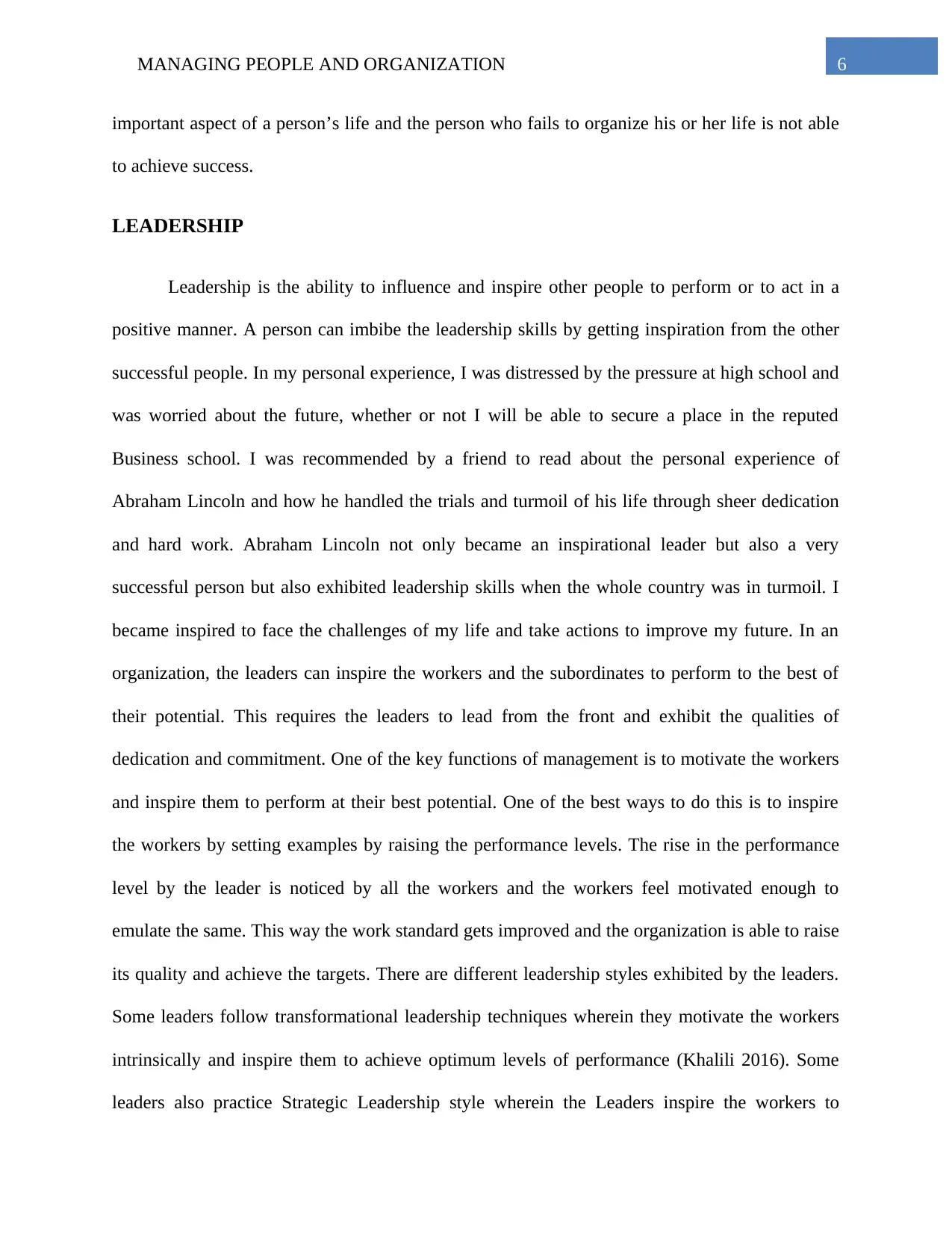
6MANAGING PEOPLE AND ORGANIZATION
important aspect of a person’s life and the person who fails to organize his or her life is not able
to achieve success.
LEADERSHIP
Leadership is the ability to influence and inspire other people to perform or to act in a
positive manner. A person can imbibe the leadership skills by getting inspiration from the other
successful people. In my personal experience, I was distressed by the pressure at high school and
was worried about the future, whether or not I will be able to secure a place in the reputed
Business school. I was recommended by a friend to read about the personal experience of
Abraham Lincoln and how he handled the trials and turmoil of his life through sheer dedication
and hard work. Abraham Lincoln not only became an inspirational leader but also a very
successful person but also exhibited leadership skills when the whole country was in turmoil. I
became inspired to face the challenges of my life and take actions to improve my future. In an
organization, the leaders can inspire the workers and the subordinates to perform to the best of
their potential. This requires the leaders to lead from the front and exhibit the qualities of
dedication and commitment. One of the key functions of management is to motivate the workers
and inspire them to perform at their best potential. One of the best ways to do this is to inspire
the workers by setting examples by raising the performance levels. The rise in the performance
level by the leader is noticed by all the workers and the workers feel motivated enough to
emulate the same. This way the work standard gets improved and the organization is able to raise
its quality and achieve the targets. There are different leadership styles exhibited by the leaders.
Some leaders follow transformational leadership techniques wherein they motivate the workers
intrinsically and inspire them to achieve optimum levels of performance (Khalili 2016). Some
leaders also practice Strategic Leadership style wherein the Leaders inspire the workers to
important aspect of a person’s life and the person who fails to organize his or her life is not able
to achieve success.
LEADERSHIP
Leadership is the ability to influence and inspire other people to perform or to act in a
positive manner. A person can imbibe the leadership skills by getting inspiration from the other
successful people. In my personal experience, I was distressed by the pressure at high school and
was worried about the future, whether or not I will be able to secure a place in the reputed
Business school. I was recommended by a friend to read about the personal experience of
Abraham Lincoln and how he handled the trials and turmoil of his life through sheer dedication
and hard work. Abraham Lincoln not only became an inspirational leader but also a very
successful person but also exhibited leadership skills when the whole country was in turmoil. I
became inspired to face the challenges of my life and take actions to improve my future. In an
organization, the leaders can inspire the workers and the subordinates to perform to the best of
their potential. This requires the leaders to lead from the front and exhibit the qualities of
dedication and commitment. One of the key functions of management is to motivate the workers
and inspire them to perform at their best potential. One of the best ways to do this is to inspire
the workers by setting examples by raising the performance levels. The rise in the performance
level by the leader is noticed by all the workers and the workers feel motivated enough to
emulate the same. This way the work standard gets improved and the organization is able to raise
its quality and achieve the targets. There are different leadership styles exhibited by the leaders.
Some leaders follow transformational leadership techniques wherein they motivate the workers
intrinsically and inspire them to achieve optimum levels of performance (Khalili 2016). Some
leaders also practice Strategic Leadership style wherein the Leaders inspire the workers to
Paraphrase This Document
Need a fresh take? Get an instant paraphrase of this document with our AI Paraphraser
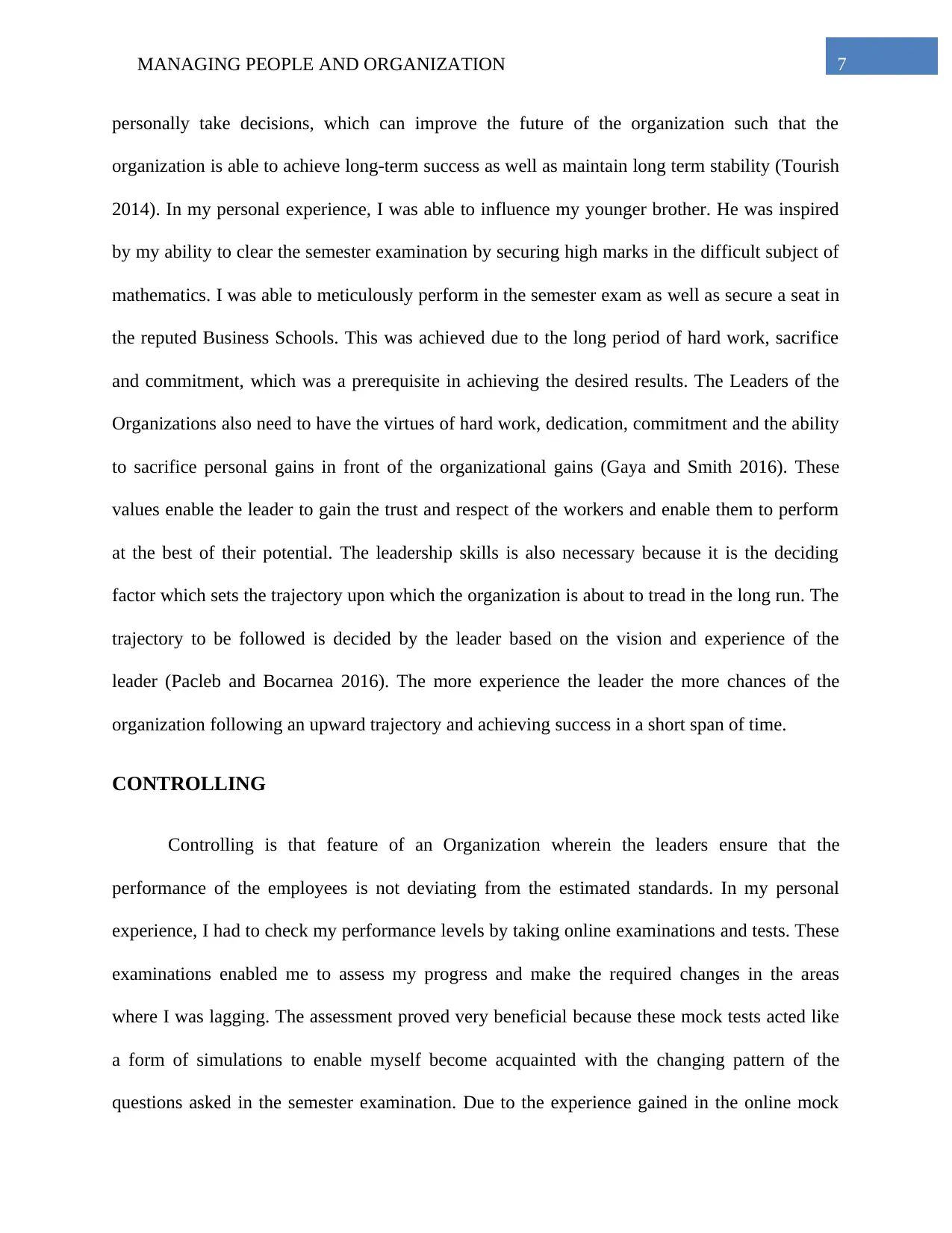
7MANAGING PEOPLE AND ORGANIZATION
personally take decisions, which can improve the future of the organization such that the
organization is able to achieve long-term success as well as maintain long term stability (Tourish
2014). In my personal experience, I was able to influence my younger brother. He was inspired
by my ability to clear the semester examination by securing high marks in the difficult subject of
mathematics. I was able to meticulously perform in the semester exam as well as secure a seat in
the reputed Business Schools. This was achieved due to the long period of hard work, sacrifice
and commitment, which was a prerequisite in achieving the desired results. The Leaders of the
Organizations also need to have the virtues of hard work, dedication, commitment and the ability
to sacrifice personal gains in front of the organizational gains (Gaya and Smith 2016). These
values enable the leader to gain the trust and respect of the workers and enable them to perform
at the best of their potential. The leadership skills is also necessary because it is the deciding
factor which sets the trajectory upon which the organization is about to tread in the long run. The
trajectory to be followed is decided by the leader based on the vision and experience of the
leader (Pacleb and Bocarnea 2016). The more experience the leader the more chances of the
organization following an upward trajectory and achieving success in a short span of time.
CONTROLLING
Controlling is that feature of an Organization wherein the leaders ensure that the
performance of the employees is not deviating from the estimated standards. In my personal
experience, I had to check my performance levels by taking online examinations and tests. These
examinations enabled me to assess my progress and make the required changes in the areas
where I was lagging. The assessment proved very beneficial because these mock tests acted like
a form of simulations to enable myself become acquainted with the changing pattern of the
questions asked in the semester examination. Due to the experience gained in the online mock
personally take decisions, which can improve the future of the organization such that the
organization is able to achieve long-term success as well as maintain long term stability (Tourish
2014). In my personal experience, I was able to influence my younger brother. He was inspired
by my ability to clear the semester examination by securing high marks in the difficult subject of
mathematics. I was able to meticulously perform in the semester exam as well as secure a seat in
the reputed Business Schools. This was achieved due to the long period of hard work, sacrifice
and commitment, which was a prerequisite in achieving the desired results. The Leaders of the
Organizations also need to have the virtues of hard work, dedication, commitment and the ability
to sacrifice personal gains in front of the organizational gains (Gaya and Smith 2016). These
values enable the leader to gain the trust and respect of the workers and enable them to perform
at the best of their potential. The leadership skills is also necessary because it is the deciding
factor which sets the trajectory upon which the organization is about to tread in the long run. The
trajectory to be followed is decided by the leader based on the vision and experience of the
leader (Pacleb and Bocarnea 2016). The more experience the leader the more chances of the
organization following an upward trajectory and achieving success in a short span of time.
CONTROLLING
Controlling is that feature of an Organization wherein the leaders ensure that the
performance of the employees is not deviating from the estimated standards. In my personal
experience, I had to check my performance levels by taking online examinations and tests. These
examinations enabled me to assess my progress and make the required changes in the areas
where I was lagging. The assessment proved very beneficial because these mock tests acted like
a form of simulations to enable myself become acquainted with the changing pattern of the
questions asked in the semester examination. Due to the experience gained in the online mock
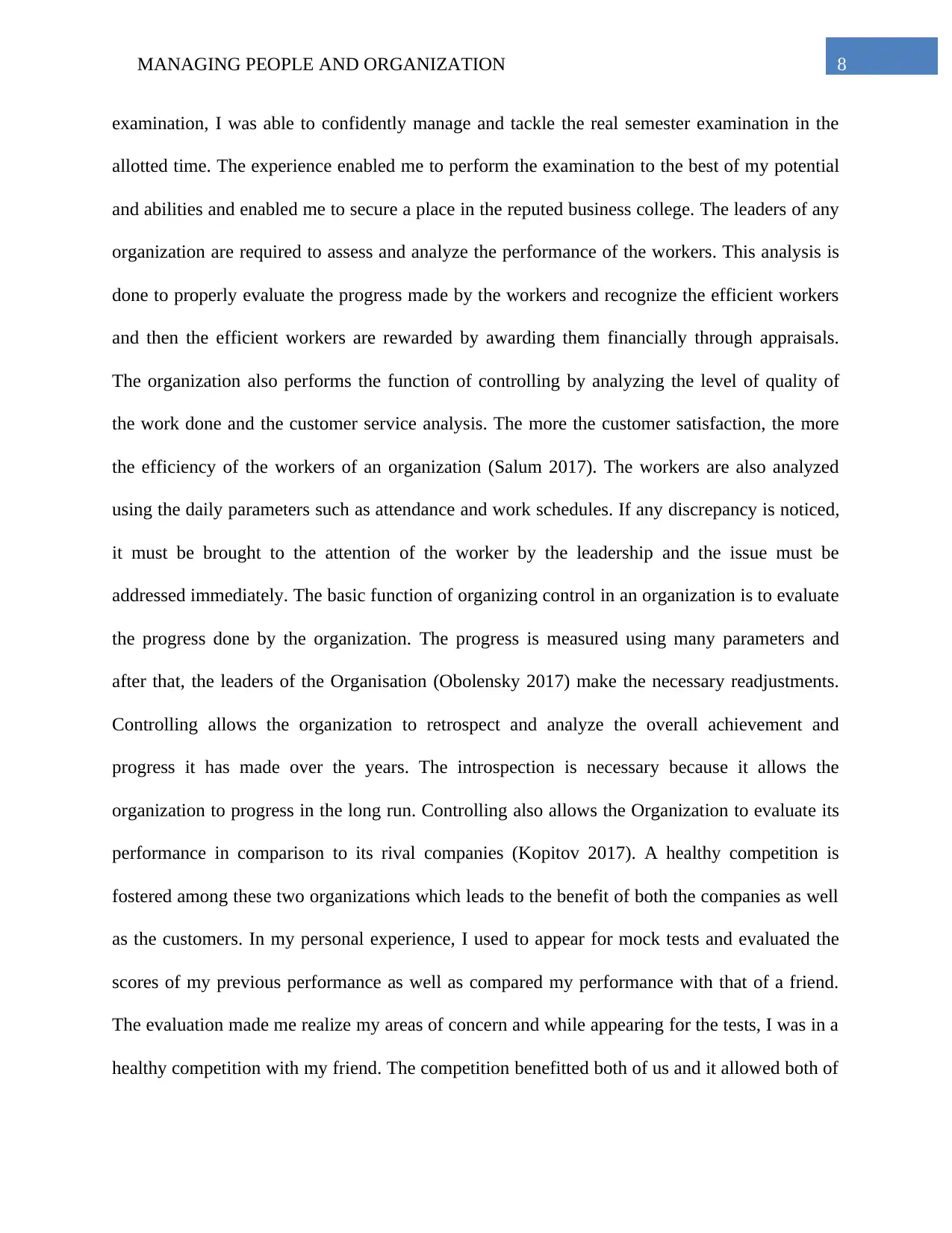
8MANAGING PEOPLE AND ORGANIZATION
examination, I was able to confidently manage and tackle the real semester examination in the
allotted time. The experience enabled me to perform the examination to the best of my potential
and abilities and enabled me to secure a place in the reputed business college. The leaders of any
organization are required to assess and analyze the performance of the workers. This analysis is
done to properly evaluate the progress made by the workers and recognize the efficient workers
and then the efficient workers are rewarded by awarding them financially through appraisals.
The organization also performs the function of controlling by analyzing the level of quality of
the work done and the customer service analysis. The more the customer satisfaction, the more
the efficiency of the workers of an organization (Salum 2017). The workers are also analyzed
using the daily parameters such as attendance and work schedules. If any discrepancy is noticed,
it must be brought to the attention of the worker by the leadership and the issue must be
addressed immediately. The basic function of organizing control in an organization is to evaluate
the progress done by the organization. The progress is measured using many parameters and
after that, the leaders of the Organisation (Obolensky 2017) make the necessary readjustments.
Controlling allows the organization to retrospect and analyze the overall achievement and
progress it has made over the years. The introspection is necessary because it allows the
organization to progress in the long run. Controlling also allows the Organization to evaluate its
performance in comparison to its rival companies (Kopitov 2017). A healthy competition is
fostered among these two organizations which leads to the benefit of both the companies as well
as the customers. In my personal experience, I used to appear for mock tests and evaluated the
scores of my previous performance as well as compared my performance with that of a friend.
The evaluation made me realize my areas of concern and while appearing for the tests, I was in a
healthy competition with my friend. The competition benefitted both of us and it allowed both of
examination, I was able to confidently manage and tackle the real semester examination in the
allotted time. The experience enabled me to perform the examination to the best of my potential
and abilities and enabled me to secure a place in the reputed business college. The leaders of any
organization are required to assess and analyze the performance of the workers. This analysis is
done to properly evaluate the progress made by the workers and recognize the efficient workers
and then the efficient workers are rewarded by awarding them financially through appraisals.
The organization also performs the function of controlling by analyzing the level of quality of
the work done and the customer service analysis. The more the customer satisfaction, the more
the efficiency of the workers of an organization (Salum 2017). The workers are also analyzed
using the daily parameters such as attendance and work schedules. If any discrepancy is noticed,
it must be brought to the attention of the worker by the leadership and the issue must be
addressed immediately. The basic function of organizing control in an organization is to evaluate
the progress done by the organization. The progress is measured using many parameters and
after that, the leaders of the Organisation (Obolensky 2017) make the necessary readjustments.
Controlling allows the organization to retrospect and analyze the overall achievement and
progress it has made over the years. The introspection is necessary because it allows the
organization to progress in the long run. Controlling also allows the Organization to evaluate its
performance in comparison to its rival companies (Kopitov 2017). A healthy competition is
fostered among these two organizations which leads to the benefit of both the companies as well
as the customers. In my personal experience, I used to appear for mock tests and evaluated the
scores of my previous performance as well as compared my performance with that of a friend.
The evaluation made me realize my areas of concern and while appearing for the tests, I was in a
healthy competition with my friend. The competition benefitted both of us and it allowed both of
⊘ This is a preview!⊘
Do you want full access?
Subscribe today to unlock all pages.

Trusted by 1+ million students worldwide
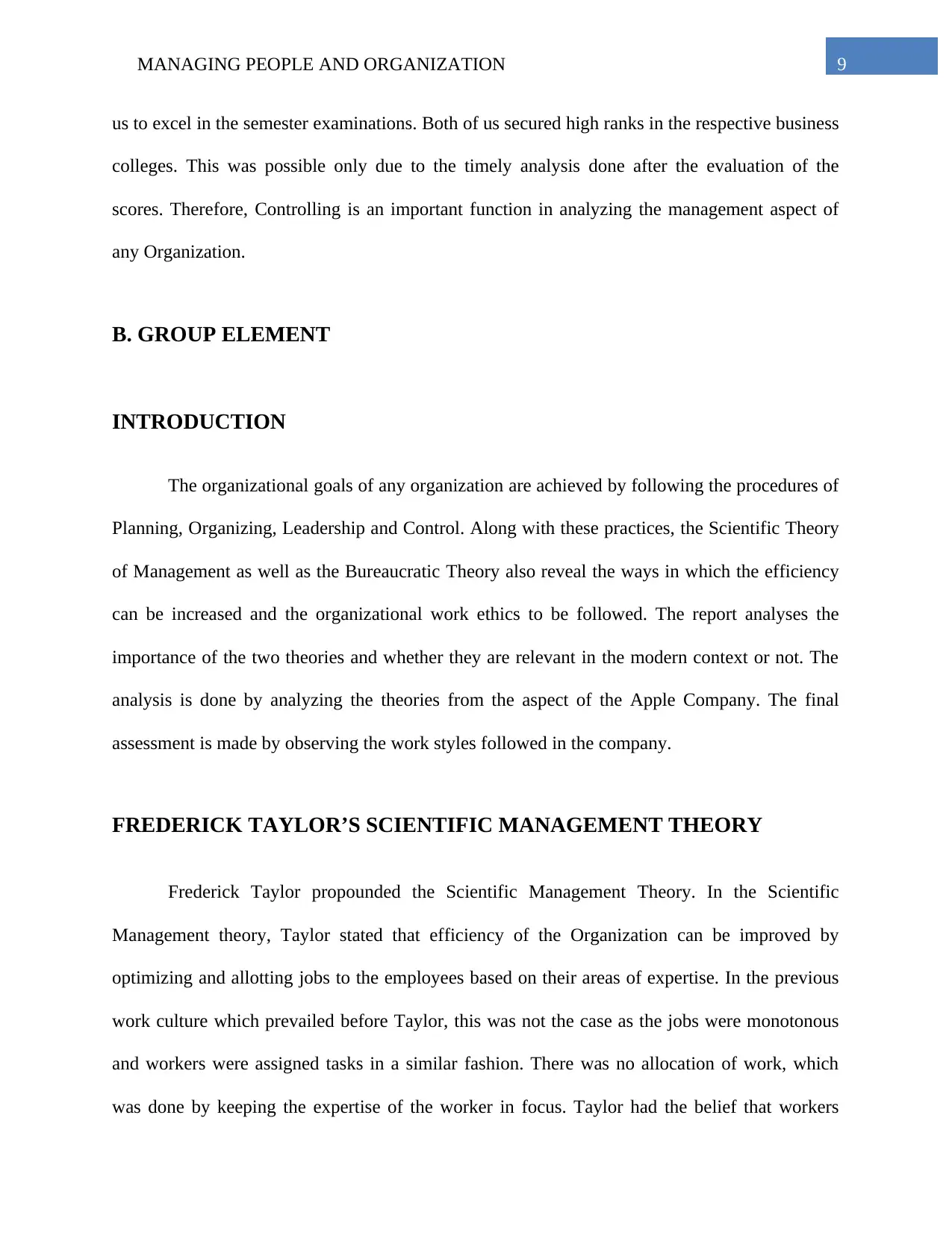
9MANAGING PEOPLE AND ORGANIZATION
us to excel in the semester examinations. Both of us secured high ranks in the respective business
colleges. This was possible only due to the timely analysis done after the evaluation of the
scores. Therefore, Controlling is an important function in analyzing the management aspect of
any Organization.
B. GROUP ELEMENT
INTRODUCTION
The organizational goals of any organization are achieved by following the procedures of
Planning, Organizing, Leadership and Control. Along with these practices, the Scientific Theory
of Management as well as the Bureaucratic Theory also reveal the ways in which the efficiency
can be increased and the organizational work ethics to be followed. The report analyses the
importance of the two theories and whether they are relevant in the modern context or not. The
analysis is done by analyzing the theories from the aspect of the Apple Company. The final
assessment is made by observing the work styles followed in the company.
FREDERICK TAYLOR’S SCIENTIFIC MANAGEMENT THEORY
Frederick Taylor propounded the Scientific Management Theory. In the Scientific
Management theory, Taylor stated that efficiency of the Organization can be improved by
optimizing and allotting jobs to the employees based on their areas of expertise. In the previous
work culture which prevailed before Taylor, this was not the case as the jobs were monotonous
and workers were assigned tasks in a similar fashion. There was no allocation of work, which
was done by keeping the expertise of the worker in focus. Taylor had the belief that workers
us to excel in the semester examinations. Both of us secured high ranks in the respective business
colleges. This was possible only due to the timely analysis done after the evaluation of the
scores. Therefore, Controlling is an important function in analyzing the management aspect of
any Organization.
B. GROUP ELEMENT
INTRODUCTION
The organizational goals of any organization are achieved by following the procedures of
Planning, Organizing, Leadership and Control. Along with these practices, the Scientific Theory
of Management as well as the Bureaucratic Theory also reveal the ways in which the efficiency
can be increased and the organizational work ethics to be followed. The report analyses the
importance of the two theories and whether they are relevant in the modern context or not. The
analysis is done by analyzing the theories from the aspect of the Apple Company. The final
assessment is made by observing the work styles followed in the company.
FREDERICK TAYLOR’S SCIENTIFIC MANAGEMENT THEORY
Frederick Taylor propounded the Scientific Management Theory. In the Scientific
Management theory, Taylor stated that efficiency of the Organization can be improved by
optimizing and allotting jobs to the employees based on their areas of expertise. In the previous
work culture which prevailed before Taylor, this was not the case as the jobs were monotonous
and workers were assigned tasks in a similar fashion. There was no allocation of work, which
was done by keeping the expertise of the worker in focus. Taylor had the belief that workers
Paraphrase This Document
Need a fresh take? Get an instant paraphrase of this document with our AI Paraphraser
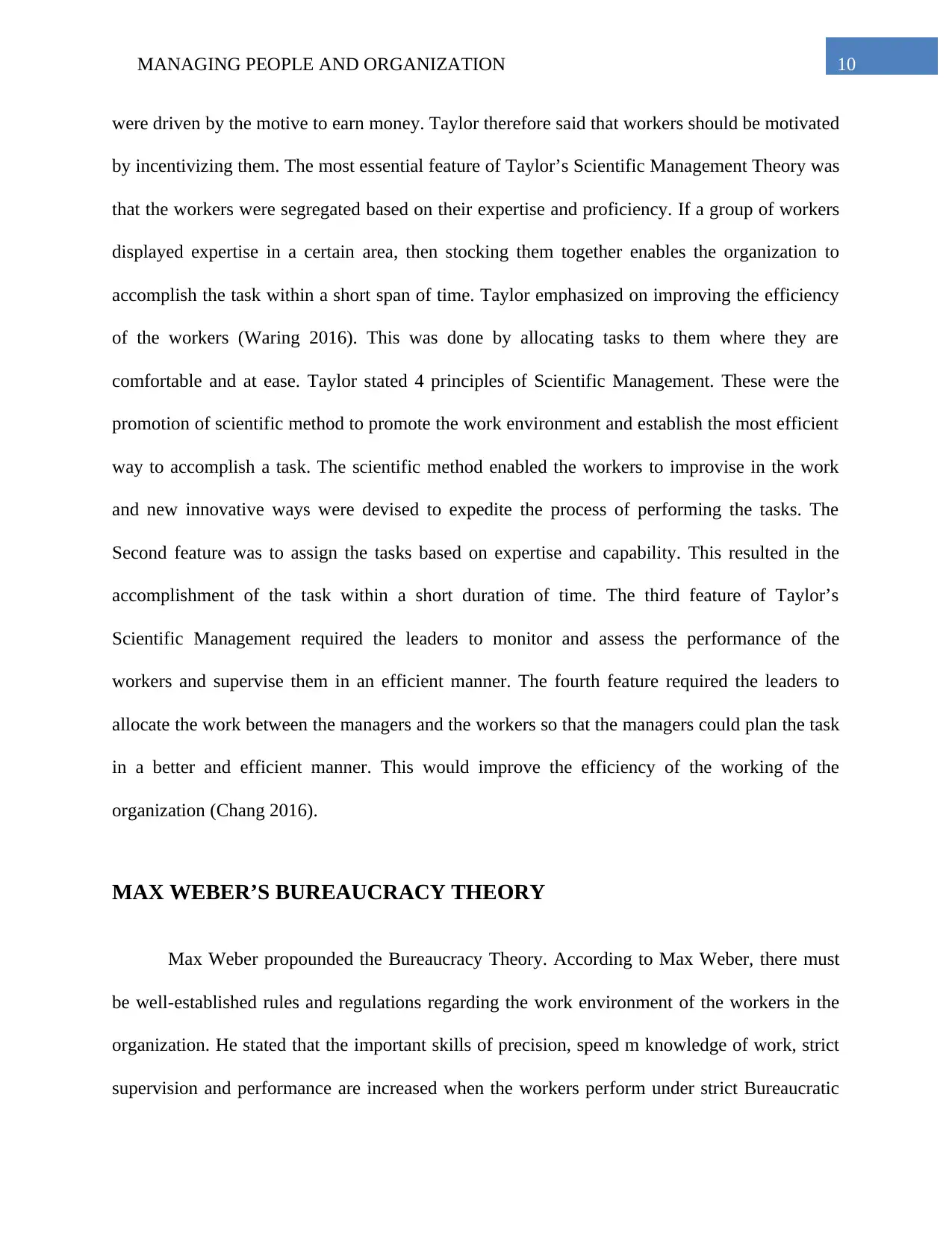
10MANAGING PEOPLE AND ORGANIZATION
were driven by the motive to earn money. Taylor therefore said that workers should be motivated
by incentivizing them. The most essential feature of Taylor’s Scientific Management Theory was
that the workers were segregated based on their expertise and proficiency. If a group of workers
displayed expertise in a certain area, then stocking them together enables the organization to
accomplish the task within a short span of time. Taylor emphasized on improving the efficiency
of the workers (Waring 2016). This was done by allocating tasks to them where they are
comfortable and at ease. Taylor stated 4 principles of Scientific Management. These were the
promotion of scientific method to promote the work environment and establish the most efficient
way to accomplish a task. The scientific method enabled the workers to improvise in the work
and new innovative ways were devised to expedite the process of performing the tasks. The
Second feature was to assign the tasks based on expertise and capability. This resulted in the
accomplishment of the task within a short duration of time. The third feature of Taylor’s
Scientific Management required the leaders to monitor and assess the performance of the
workers and supervise them in an efficient manner. The fourth feature required the leaders to
allocate the work between the managers and the workers so that the managers could plan the task
in a better and efficient manner. This would improve the efficiency of the working of the
organization (Chang 2016).
MAX WEBER’S BUREAUCRACY THEORY
Max Weber propounded the Bureaucracy Theory. According to Max Weber, there must
be well-established rules and regulations regarding the work environment of the workers in the
organization. He stated that the important skills of precision, speed m knowledge of work, strict
supervision and performance are increased when the workers perform under strict Bureaucratic
were driven by the motive to earn money. Taylor therefore said that workers should be motivated
by incentivizing them. The most essential feature of Taylor’s Scientific Management Theory was
that the workers were segregated based on their expertise and proficiency. If a group of workers
displayed expertise in a certain area, then stocking them together enables the organization to
accomplish the task within a short span of time. Taylor emphasized on improving the efficiency
of the workers (Waring 2016). This was done by allocating tasks to them where they are
comfortable and at ease. Taylor stated 4 principles of Scientific Management. These were the
promotion of scientific method to promote the work environment and establish the most efficient
way to accomplish a task. The scientific method enabled the workers to improvise in the work
and new innovative ways were devised to expedite the process of performing the tasks. The
Second feature was to assign the tasks based on expertise and capability. This resulted in the
accomplishment of the task within a short duration of time. The third feature of Taylor’s
Scientific Management required the leaders to monitor and assess the performance of the
workers and supervise them in an efficient manner. The fourth feature required the leaders to
allocate the work between the managers and the workers so that the managers could plan the task
in a better and efficient manner. This would improve the efficiency of the working of the
organization (Chang 2016).
MAX WEBER’S BUREAUCRACY THEORY
Max Weber propounded the Bureaucracy Theory. According to Max Weber, there must
be well-established rules and regulations regarding the work environment of the workers in the
organization. He stated that the important skills of precision, speed m knowledge of work, strict
supervision and performance are increased when the workers perform under strict Bureaucratic
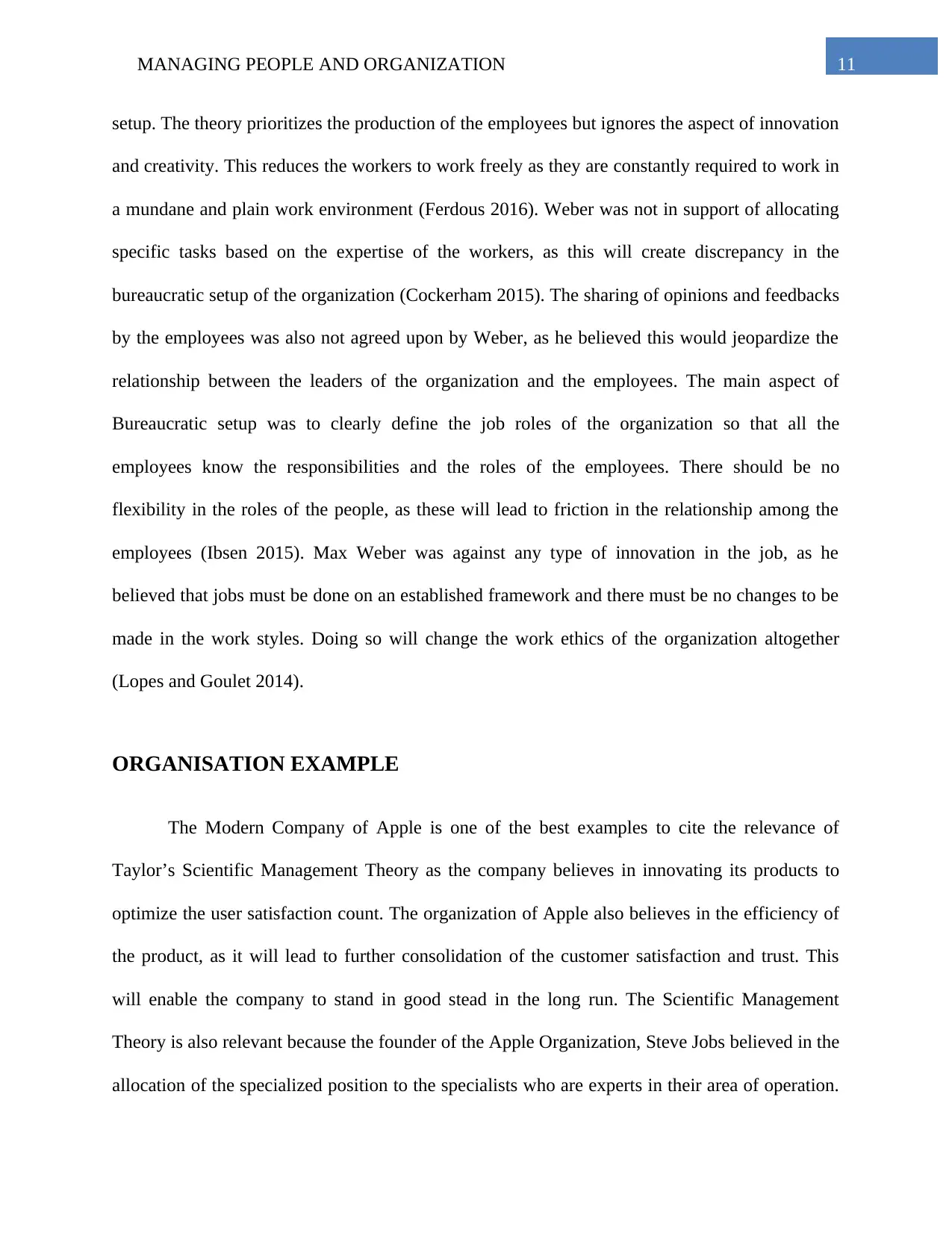
11MANAGING PEOPLE AND ORGANIZATION
setup. The theory prioritizes the production of the employees but ignores the aspect of innovation
and creativity. This reduces the workers to work freely as they are constantly required to work in
a mundane and plain work environment (Ferdous 2016). Weber was not in support of allocating
specific tasks based on the expertise of the workers, as this will create discrepancy in the
bureaucratic setup of the organization (Cockerham 2015). The sharing of opinions and feedbacks
by the employees was also not agreed upon by Weber, as he believed this would jeopardize the
relationship between the leaders of the organization and the employees. The main aspect of
Bureaucratic setup was to clearly define the job roles of the organization so that all the
employees know the responsibilities and the roles of the employees. There should be no
flexibility in the roles of the people, as these will lead to friction in the relationship among the
employees (Ibsen 2015). Max Weber was against any type of innovation in the job, as he
believed that jobs must be done on an established framework and there must be no changes to be
made in the work styles. Doing so will change the work ethics of the organization altogether
(Lopes and Goulet 2014).
ORGANISATION EXAMPLE
The Modern Company of Apple is one of the best examples to cite the relevance of
Taylor’s Scientific Management Theory as the company believes in innovating its products to
optimize the user satisfaction count. The organization of Apple also believes in the efficiency of
the product, as it will lead to further consolidation of the customer satisfaction and trust. This
will enable the company to stand in good stead in the long run. The Scientific Management
Theory is also relevant because the founder of the Apple Organization, Steve Jobs believed in the
allocation of the specialized position to the specialists who are experts in their area of operation.
setup. The theory prioritizes the production of the employees but ignores the aspect of innovation
and creativity. This reduces the workers to work freely as they are constantly required to work in
a mundane and plain work environment (Ferdous 2016). Weber was not in support of allocating
specific tasks based on the expertise of the workers, as this will create discrepancy in the
bureaucratic setup of the organization (Cockerham 2015). The sharing of opinions and feedbacks
by the employees was also not agreed upon by Weber, as he believed this would jeopardize the
relationship between the leaders of the organization and the employees. The main aspect of
Bureaucratic setup was to clearly define the job roles of the organization so that all the
employees know the responsibilities and the roles of the employees. There should be no
flexibility in the roles of the people, as these will lead to friction in the relationship among the
employees (Ibsen 2015). Max Weber was against any type of innovation in the job, as he
believed that jobs must be done on an established framework and there must be no changes to be
made in the work styles. Doing so will change the work ethics of the organization altogether
(Lopes and Goulet 2014).
ORGANISATION EXAMPLE
The Modern Company of Apple is one of the best examples to cite the relevance of
Taylor’s Scientific Management Theory as the company believes in innovating its products to
optimize the user satisfaction count. The organization of Apple also believes in the efficiency of
the product, as it will lead to further consolidation of the customer satisfaction and trust. This
will enable the company to stand in good stead in the long run. The Scientific Management
Theory is also relevant because the founder of the Apple Organization, Steve Jobs believed in the
allocation of the specialized position to the specialists who are experts in their area of operation.
⊘ This is a preview!⊘
Do you want full access?
Subscribe today to unlock all pages.

Trusted by 1+ million students worldwide
1 out of 17
Related Documents
Your All-in-One AI-Powered Toolkit for Academic Success.
+13062052269
info@desklib.com
Available 24*7 on WhatsApp / Email
![[object Object]](/_next/static/media/star-bottom.7253800d.svg)
Unlock your academic potential
Copyright © 2020–2025 A2Z Services. All Rights Reserved. Developed and managed by ZUCOL.





